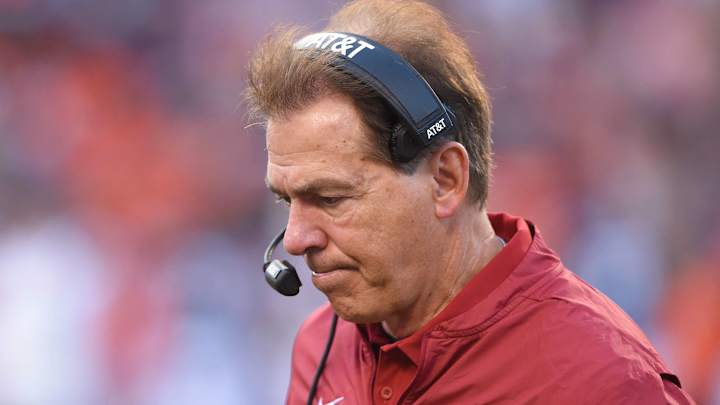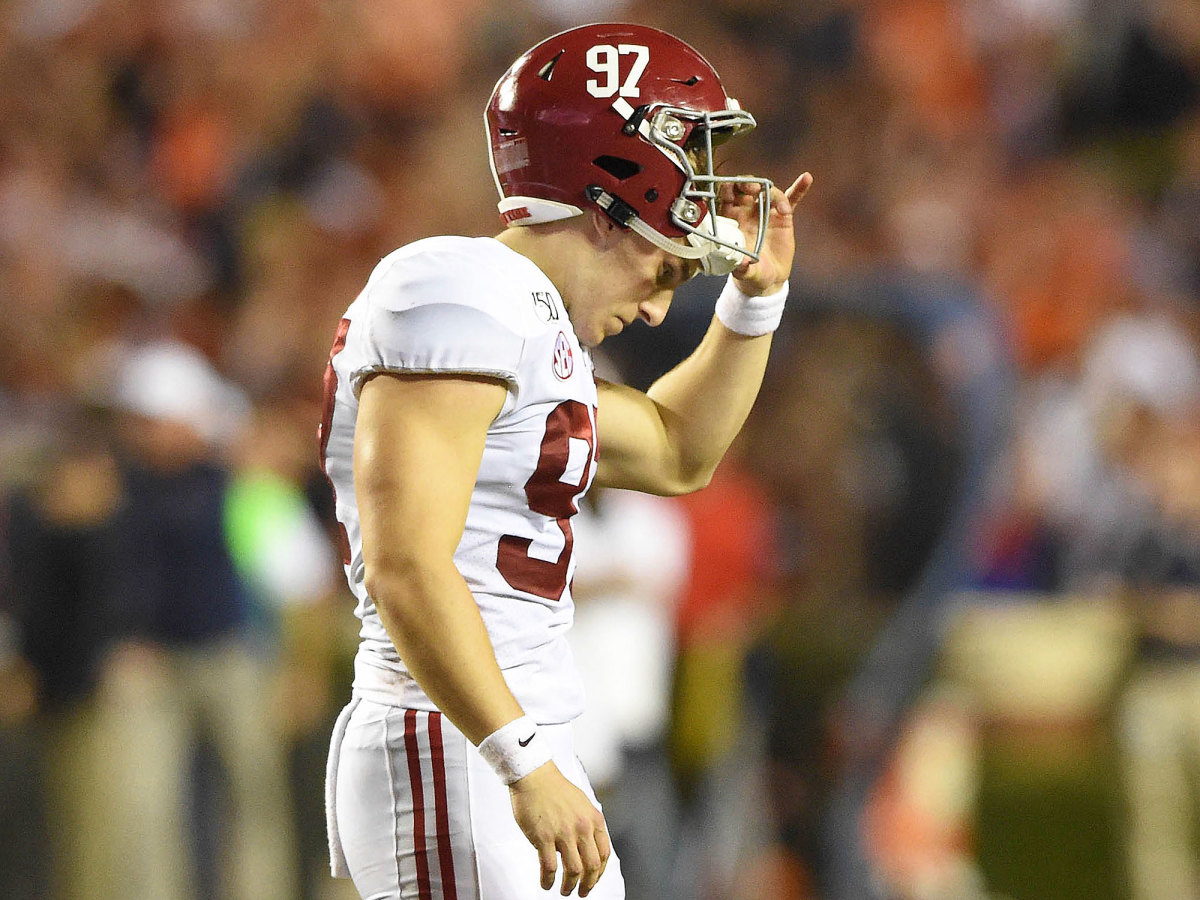Iron Bowl Loss May Portend New Reality for Alabama

AUBURN, Ala. — Alabama fans can forever curse the South end zone of Jordan-Hare Stadium. It’s the place where Crimson Tide field goals go to die and the Iron Bowl has been lost twice in six years. The Kick Six was launched from that end zone in 2013. And The Joe No now has happened there, too—Joe Bulovas doinking the upright on a tying field goal attempt from 30 yards out and two minutes remaining, paving the way for a 48-45 Auburn triumph.
Alabama fans can bemoan the two pick-six interceptions quarterback Mac Jones threw, spoiling an otherwise remarkable performance by the guy who spent nine games backing up star QB Tua Tagovailoa. One of them was a 29-yarder on an overthrow in the first half. The other a staggering 100-yarder in the third quarter that officially pushed this wild game over the edge into the surreal. That one actually bounced off the back of intended receiver Najee Harris and into the hands of Zakoby McClain, a flukish gift that Auburn gladly accepted.
Alabama fans can lament their team’s 13 penalties for 96 yards, the final flag sealing the game. Nick Saban described that one as “an unfair play,” citing duplicity by counterpart Gus Malzahn in sending punter Arryn Siposs onto the field as a wide receiver and fooling the Crimson Tide into having 12 men on the field. (If you think a 68-year-old coach declaring “unfair” seems more like something that would come out of the mouth of an 8-year-old, you’re not alone.)
Alabama fans can wonder how their team could twice lose games in which the Tide scored 40 points—scoring 41 and giving up 46 to LSU, then two more than that here to the Tigers. The 46 was the most a Saban-coached Alabama team had ever allowed. That low point lasted three weeks.
But mostly what Alabama fans need to do is accept the totality of all the above. Roll it all together and it means one thing: the 10-2 Crimson Tide aren't good enough.
Alabama has slipped. And it may not get back up anytime soon.
For the first time in its six-year history, the College Football Playoff will roll on without the Tide. For the first time since 2013-14, the sport will go consecutive years without Alabama winning a natty. For the first time since 2010, Alabama has lost to SEC West rivals LSU and Auburn in the same season.
The dynasty may or may not be dead. But the era of dominance certainly appears to be over.
There was some bad injury luck this season—the loss of Tagovailoa late and All-American linebacker Dylan Moses before the season robbed the Tide of its best player on either side of the ball. There were some crazy circumstances Saturday—a 100-yard interception return of a ball that bounces off a guy’s back and perfectly into the hands of a defensive player; a controversial final second of the first half, in which Auburn got off a field goal when the clock probably should have expired.
But football is full of injuries and fluke plays and shaky officiating calls. Those are excuses. This is reality: Alabama has misplaced—if not outright lost—its Saban DNA.
The greatest defensive coach in the history of the sport has seen his team give up 34, 44, 46 and 48 points in its last four games against Top 20 opponents. The first total was to Oklahoma in the playoff semifinals last season, and the second was to Clemson in the final. The other two are this season. To date this Alabama defense is giving up 18.8 points per game, the most since Saban’s first year at the school in 2007.
The most buttoned-up coach of the 21st century has seen his team become increasingly sloppy. Alabama came into this game ranked 116th nationally in penalty yards, a completely unheard-of situation for a Saban-coached Tide team—then it was flagged for a season-high number of infractions and amount of yardage.
And the place-kicking game continues to stink. That’s long been a baffling Alabama affliction, but the Tide were almost always too good to lose because of it. Saturday, it cost them the chance to potentially get the Iron Bowl into overtime.

“We came here with the idea of playing with a great deal of discipline,” Saban said. “… And I don’t think we did that. … When you play against good teams, those things bite you. It’s my responsibility to get our team to play better.”
The 2019 Alabama team has accomplished virtually nothing by its own mile-high standards. There have been no quality wins, and there are no championships. The Tide rolled through the meek majority of the schedule and lost to the only two high-level opponents they faced.
So we will see what else Alabama may have lost since that shocking comeuppance against Clemson, and on through the defeats against LSU and Auburn. This simply doesn’t look like the same program as it once was.
Is the aura of invincibility gone? Could be.
“Our players believe we can beat them,” said Malzahn, now the only active coach to have beaten a Saban-coached Alabama team three times. “All other teams, for the most part, hope.”
That hope could grow into belief going forward for others in the SEC.
The only college football constant more reliable than Saban-coached excellence is that nothing lasts forever. Dynasties are never eternal. The coach of the Crimson Tide might have the same energy and drive as ever—but eventually, inevitably, things slip. A program culture built on a seemingly unbreakable foundation can erode.
Where does Alabama go from here? Into a bowl game that will have some prestige but not one that carries national title implications. Will that lead to some key players opting to sit out, a problem ‘Bama hasn’t had to deal with?
What about coaching staff? There will be more turnover, at a place where the churn has been constant in recent years. The challenge of replacing talented assistants with other talented assistants will continue.
The best quarterback in school history is likely to go pro, along with the usual exodus of other talented players who have eligibility remaining. Will the next wave be as good? LSU, Clemson and Ohio State—the three teams still unbeaten—all rank ahead of Alabama in the current rivals.com recruiting rankings.
Alabama losses have been so rare over the years that they provoke a tendency to overreact. But the calendar year 2019 feels different—like the warning signs are real this time.
The program’s proud fans can dwell on the elements of this Iron Bowl defeat. But the bigger picture suggests that they are symptoms of a larger problem.
Alabama isn’t what it has been. And it may have a hard time regaining what it has lost.
